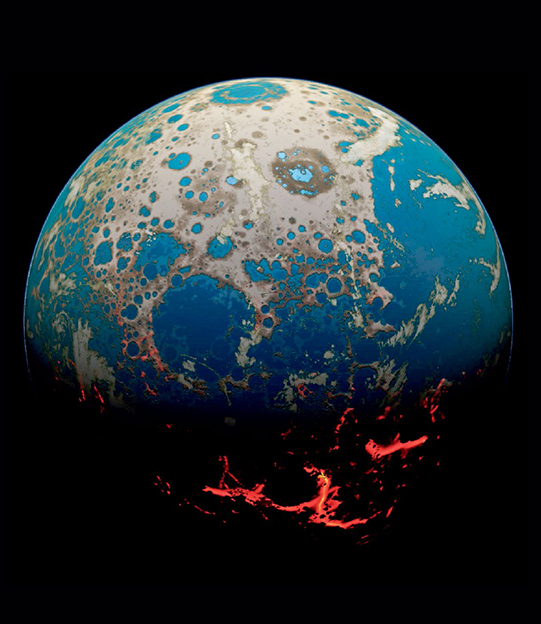c. 4 Billion BCE
Earth’s Oceans
During the Hadean (hellish) eon between about 4.5 and 4 billion years ago, huge quantities of molten volcanic lava erupted onto Earth’s surface. Along with that liquid rock, a lot of gases were also “erupted,” including hydrogen, ammonia, methane, carbon dioxide (CO2), sulfur dioxide (SO2), and water vapor, forming Earth’s steamy earliest atmosphere. As the Earth cooled and transitioned into the Archean eon around 4 billion years ago, the pressure and temperature conditions began to allow large quantities of water to routinely be stable as a liquid on the surface (rather than as steam in the atmosphere). Earth’s oceans were born.
Where did all these volatile gases come from? Perhaps the comets and especially asteroids/planetesimals that collided and eventually grew to become the Earth contained water, which became trapped in the subsurface as the Earth grew, but slowly escaped via Hadean volcanism. Or perhaps the steady rain of comets and asteroids that have been crashing into our planet during and since the Hadean delivered a so-called “late veneer” of water to the Earth, which condensed and became the oceans. Both ideas have merit. Even today, for example, large quantities of water (and CO2, SO2, and other gases) can be measured coming out of active volcanoes. Comets and asteroids also continue to strike the Earth (though rarely); studies of surviving meteorites show that some of them are indeed water-rich. Perhaps Earth’s oceans came from both internal and external sources of water.
CO2 and ammonia dissolve in water, and Earth’s early oceans quickly became a “sink” for dissolving enormous quantities of these compounds, removing most of them from the atmosphere. Many scientists believe that the result was an Archean atmosphere that could have had abundant hydrogen and methane and much less free oxygen (much like the atmosphere of Saturn’s large moon Titan today). Scientists refer to this as the reducing (as opposed to oxidizing) model of early Earth’s atmosphere. Experiments dating back to the 1950s have shown that when liquid water in contact with such an atmosphere is exposed to energy sources like lightning or solar UV radiation, the result can be the formation of abundant organic molecules, including simple amino acids and other essential building blocks of life.
SEE ALSO The Hadean (c. 4.5–4 Billion BCE), The Archean (c. 4–2.5 Billion BCE), Plate Tectonics (c. 4–3 Billion BCE), Earth’s Oceans Evaporate (~1 Billion)
Artist’s concept of the Earth near the end of the Hadean/beginning of the Archean, when liquid-water seas and oceans began to be stable on the surface. Large impact basins, just like those still preserved on the Moon today, provide evidence of continuing bombardment by asteroids and comets.
